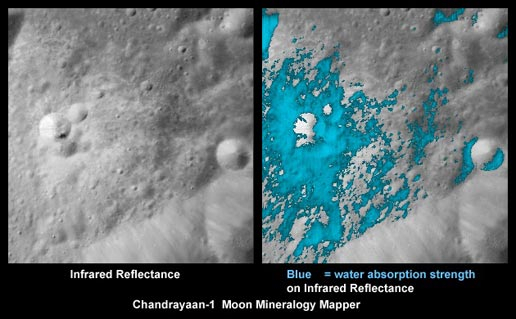
A new research by NASA has proved that water present in the moon is widely spread across the lunar surface, contradicting with the previous findings which pointed that water is present only in the north and south poles of the moon.
By analyzing data of two lunar missions, researchers found the traces of H2O and OH (hydroxyl) in the lunar surface. Hydroxyl is basically a more reactive form of water, and it should be extracted from minerals.
The research team has also found that water present on the moon is not attached loosely to the lunar surface. The findings of this new research are published in journal Nature Geoscience.
"We find that it doesn't matter what time of day or which latitude we look at, the signal indicating water always seems to be present. The presence of water doesn't appear to depend on the composition of the surface, and the water sticks around," said Joshua Bandfield, a senior research scientist with the Space Science Institute in Boulder, and the lead author of the study.
As the new finding surfaced online, NASA said that future lunar experiments will check whether this water in moon can be used as drinking water for astronauts or converted to use for fuel oil.
"Water, water, everywhere, but is there a drop to drink? Data from 2 lunar missions finds evidence that the Moon's water is widely distributed across the surface. If the Moon has enough accessible, it could be an essential resource to future explorers," posted NASA in their official Twitter handle.
Scientists are now researching more about the source of water on the moon's surface. Most of the experts believe that H2O or OH is being brought to the lunar surface by the solar wind which slams across the moon. The research team did not ignore the fact that water might have originated from the moon itself. Scientists who believe this theory claim that water particles might have trapped in the deep interiors of minerals since the natural satellite's formation.
Water, water, everywhere, but is there a drop to drink? Data from 2 lunar missions finds evidence that the Moon’s water is widely distributed across the surface. If the Moon has enough accessible 🌊, it could be an essential resource to future explorers: https://t.co/4NuyjtO4uS pic.twitter.com/VlkTTKJqcp
— NASA (@NASA) February 24, 2018









